Given the NSAP address of 49.0012.1234.1234.1234.00, what area does the IS-IS router reside in?
Graceful Restart is supported by what IGPs?
What must be configured on the Alcatel-Lucent 7750 SR for RIP to advertise locally attached links?
Which of the following commands can be used to display the number of SPF computations that have been performed on a router?
An operator configures an Alcatel-Lucent 7750 SR with a loopback interface and IPv6 address. The operator then configures a routing policy to redistribute the loopback prefix into OSPFv3. What type of LSA is used to advertise the route to other OSPFv3 routers in the same area?
Static routing will be used in a network between a corporate head office, with many connected networks, and a branch office, with one connection to the head office. Which of the following best describes the likely configuration?
What address is used when RIPv2 uses multicast to send its updates?
NSSA LSA packets are what type within an NSSA area, and are converted to what other type at the ABR?
What are some of the characteristics of Alcatel-Lucent's implementation of non-stop routing? (Choose two)
What is the value of the protocol discriminator used to denote IS-IS protocol information?
An OSPF ASBR must have at least one interface in the backbone area (area 0)
Which of the following statements regarding the election of the designated router (DR) by OSPF routers are true? (Choose two)
Refer to the exhibit below.
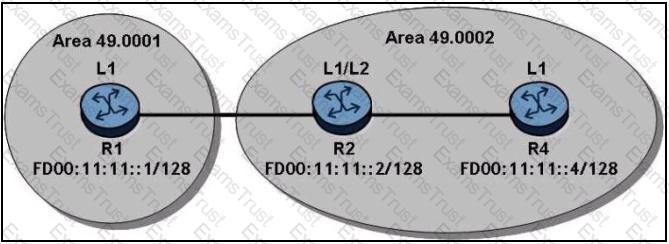
R1 distributes its loopbacks into IS-IS and globally routed addresses are configured as shown. How many routes will R4 have in its IPv6 route table?
Which type of IS-IS router is summarization most likely to be configured on?
What command is used on the Alcatel-Lucent 7750 SR to define the default action to be taken if a packet does not match any entry in an IP filter?
Which of the following statements describe the major features of OSPF? Choose two answers.
A static route is created using the command "static-route 0.0.0.0/0 next-hop 3.3.3.1". What command could be used to test the static route on an Alcatel-Lucent 7750 SR?
There is an IP host with IP address 10.2.3.1. A static route is created, using the "configure router static-route 10.2.3.0/24 next-hop 10.1.2.1" command. What is the correct traceroute command to test this static route on an Alcatel-Lucent 7750 SR?
Which of the statements below best describes the pseudonode in an IS-IS network?
Refer to the exhibit.
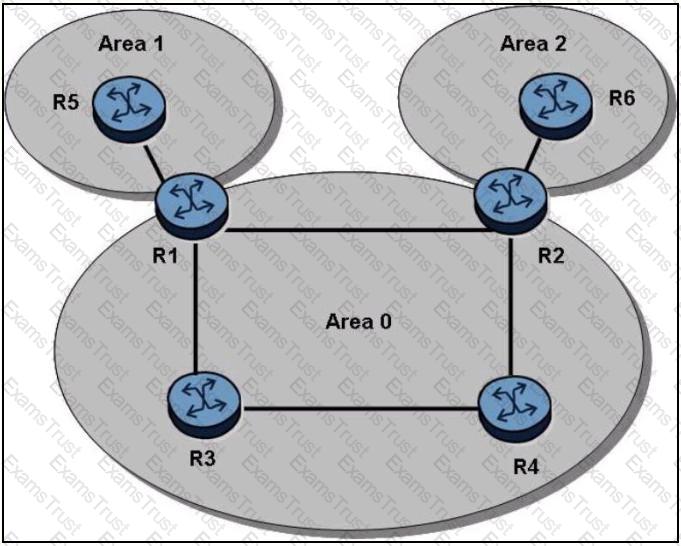
Assume that OSPFv3 is properly configured on all routers and that R4 advertises its system prefix into Area 0. Which of the following statements best describes how R5 learns R4's IPv6 system prefix?
Which of the following features are supported by IS-IS? Choose three answers.
What value should the AFI be set to for locally administered addressing?
Identify two attributes of Distance Vector Protocols: (Choose two)
In an OSPF Hello packet what fields must match all neighbor routers on the segment? (Choose 3)
What command will show the IS-IS neighbors, and their status on an Alcatel-Lucent 7750 SR?
If routers R1 and R2 have a Level 1 and Level 2 IS-IS adjacency, which of the following statements is true? Choose two answers.
What is wrong with the following filter configuration from an Alcatel-Lucent 7750 SR?
RTR-B# configure filter
RTR-B>config>filter# ip-filter 1 create
RTR-B>config>filter>ip-filter$ entry 1 create
RTR-B>config>filter>ip-filter>entry$ match src-ip 172.2.0.0/16
RTR-B>config>filter>ip-filter>entry# action drop
RTR-B# configure router interface toRTR-A
RTR-B>config>router>if# egress
RTR-B>config>router>if>egress# filter ip 1
Which three IS-IS PDU types are used for database synchronization?
Click the exhibit button.
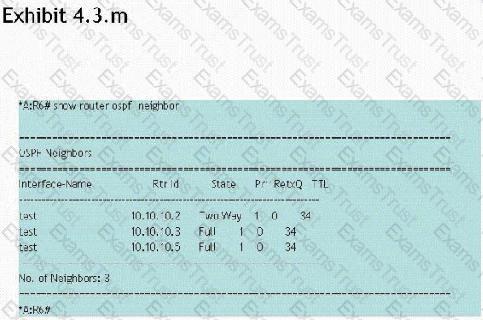
What can you deduce from the show command on router R6?
Click the exhibit button.
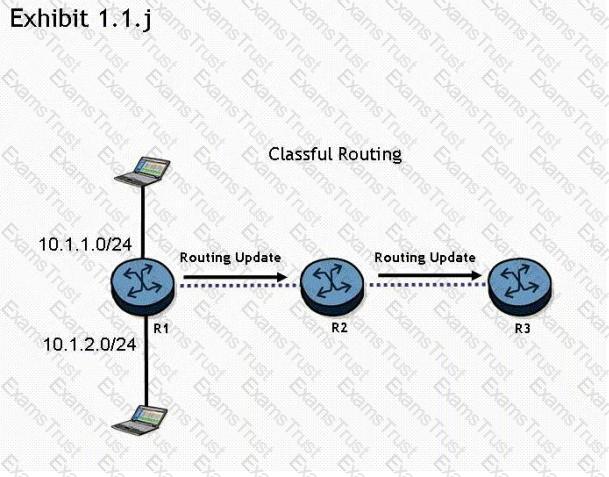
Routers R1 „ R2, and R3 are running a classful routing protocol between them. Assuming that router R1 advertises all directly connected networks, how will these networks be represented in router R3's routing table?
Which of the following statements regarding IS-IS DIS is false?
Click the exhibit button.
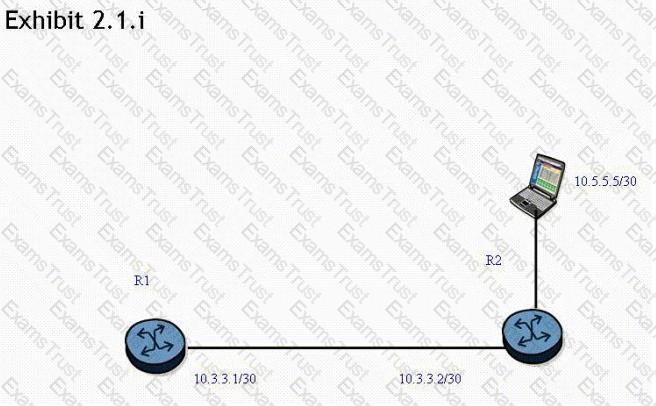
A static route is created on router R1 "using the "static-route 0.0.0.0/0 next-hop 10.3.3.2" command. What command can be used to test the static route on an Alcatel-Lucent 7750 SR?
An SDP using GRE encapsulation is configured for an E-pipe service. The network port used by the SDP has an MTU of 8000. What value does the SDP path MTU have by default on an Alcatel-Lucent 7750 SR?
Click the exhibit.
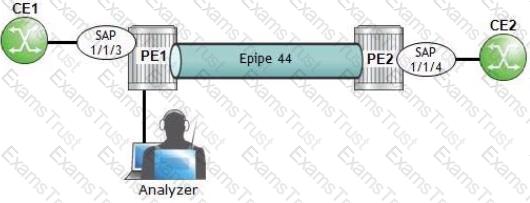
An operator at PE1 wants to analyze the traffic between CE1 and PE1 on SAP 1/1/3, On an Alcatel-Lucent 7750 SR, which of the following is NOT required as part of the configuration?
Click the exhibit.
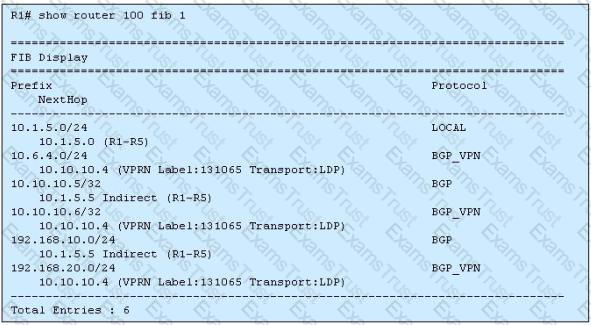
Based on this output from PE router R1, how many other PEs are participating in the VPRN?
A customer requests that their Layer 2 Ethernet service be configured to forward frames up to 1514 bytes. The service provider is using MPLS encapsulation and RSVP-TE fast-reroute with facilities bypass on their redundant IP/MPLS network. What is the minimum MTU setting for the network ports?
Which of the following statements about SAPs that are part of a VPVVS is FALSE?
Which of the following regarding 6VPE is FALSE?
By default, what happens when a packet with a VLAN tag is received on a SAP provisioned with null encapsulation?
On which object is ADSPEC enabled?
Which of the following best describes a local Epipe Service?
Which of the following statements best describes the flooding of traffic on a PE when traffic is received on a mesh SDP?
Which of the following about the label stack of a VPRN is FALSE?
Which of the following about route distinguishes on the Alcatel-Lucent 7750 SR is TRUE?
Which command provides a summary status of the VPLS service 100?
Which protocol is used to signal the service label for a Layer 3 VPRN service?
Which of the following about IES is FALSE?
What happens by default on an Alcatel-Lucent 7750 SR when a null encapsulated SAP receives a frame with a VLAN tag?
Click the exhibit.
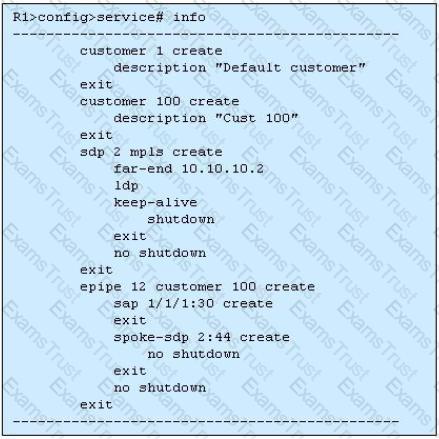
Based on the output shown, what is the value of the service's VC ID?
When using MP-BGP for an IPv4 VPRN service, what address family needs to be used for a PE-CE BGP session?
Click the exhibit.
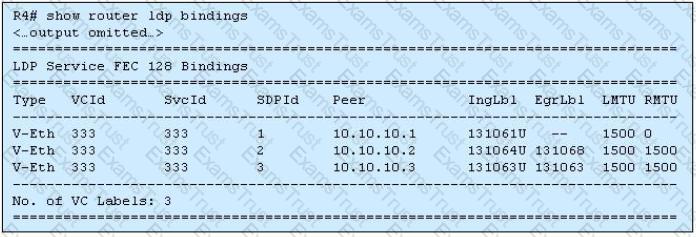
This is output from router R4. Service 333 is a VPLS. Why does peer 10.10.10.1 not have an EgrLbl?
Which of the following best describes how a MAC FDB is populated in a VPLS service?
Click the exhibit.
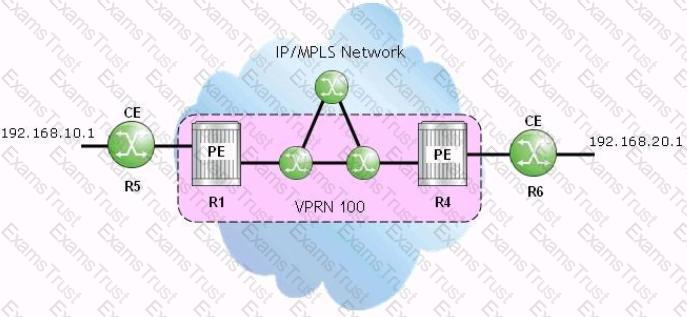
The CEs use BGP and export policies to advertise their local prefixes with the VPRN on their PEs. If the VPRN is functioning properly, which of the following commands will succeed when performed on router R1?
Which of the following about dot1Q SAPs is FALSE?
An E-pipe is configured with a service MTU of 5000. What value will be derived for the VC-MTU?
Which of the following about VPRNs is TRUE?
A network consists of four PE routers. A customer requires a VPLS and has sites connected to each PE. The VPLS is fully meshed using IP/MPLS. How many SDPs must be configured on each PE?
Click the exhibit.
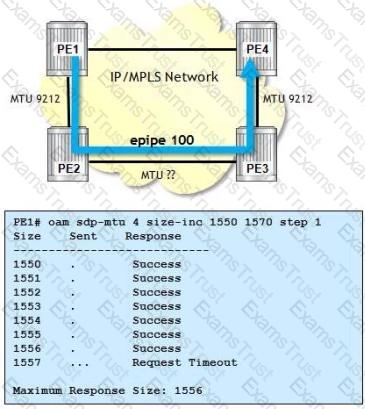
E-pipe 100 is using an SDP with an LSP that uses the path shown (PE1-PE2-PE3-PE4). Based on the OAM command output, which of the following is FALSE?
Which of the following statements are FALSE regarding the VPN-IPv4 address family? (Choose 2)
Click the exhibit.
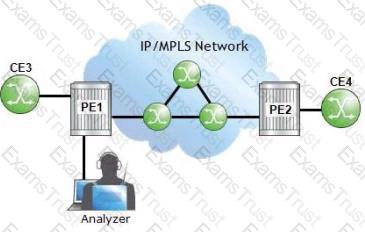
The operator at PE1 wants to analyze the traffic between PE2 and CE4. On an Alcatel-Lucent 7750 SR, which of the following is required as part of the configuration?
Click the exhibit.
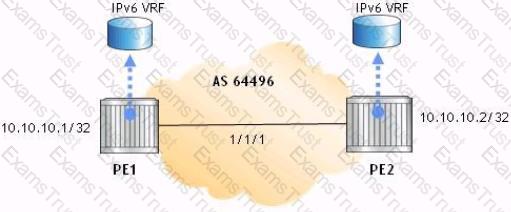
The two PEs are providing 6VPE and IPv4 VPRNs. The core network is IPv4/MPLS. Which of the following is the BGP family configuration for the MP-BPG on the PEs?
A transport tunnel can either use an MPLS or GRE encapsulation.
When configuring distributed services across a network, it is considered best practice to configure which of the following parameters as globally significant?
On an Alcatel-Lucent 7750 SR, which vc-type will strip service delimiting tags at the ingress PE?
An ES service can have both MAC and IP filters applied to it.
Click on the exhibit.
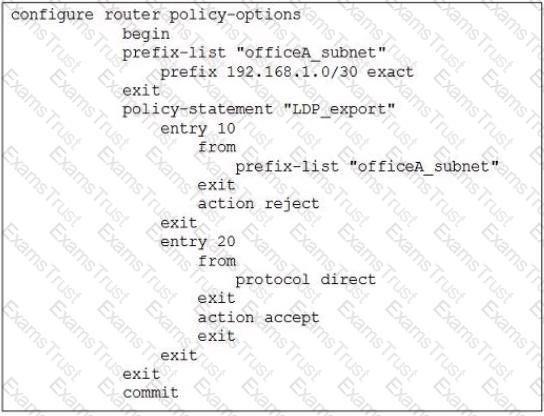
This policy is applied as an LDP export policy. In addition to the FECs learned from its neighbors, which FECs will appear in this router's LIB?
Click on the exhibit.
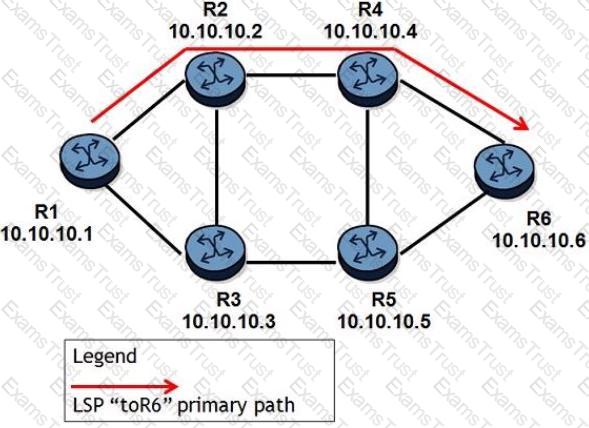
An LSP traverses R1-R2-R4-R6 and facility fast reroute with link protection is enabled. All links have the same cost. Which of the following about PLRs and MPs is TRUE?
Which of the following statements is TRUE concerning a VPRN data plane flow?
Which of the following about LDP-over-RSVP is TRUE?
Which of the following about IS-IS Traffic Engineering on an Alcatel-Lucent 7750 SR is FALSE?
Which of the following about configuring an LSP path definition on an Alcatel-Lucent 7750 SR is FALSE?
What does a PE do when a frame is received in a VPLS service with an unknown destination address by default?
To enable the LDP-over-RSVP feature, which of the following configurations is NOT required on an Alcatel-Lucent 7750 SR?
Which of the following statements is NOT a valid reason to use MP-BGP as a routing protocol to transport VPRN routes?
Which of the following regarding the location of an MPLS label is FALSE?
What happens when a packet without a VLAN tag is received on a SAP provisioned with null encapsulation while an SDP vc-type is provisioned as vlan?
What labels are encapsulated in the tunnels used by a 6PE deployment?
Which of the following is NOT a characteristic of MPLS?
Which of the following encapsulation types on an Ethernet port support the provisioning of multiple SAPs? (Choose 2)
Which of the following about the RSVP-TE Hello protocol is FALSE?
Click on the exhibit.
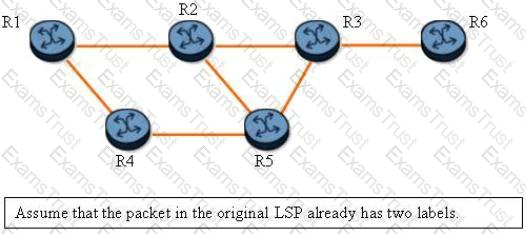
An LSP traverses the path R1-R2-R3-R6 and facility fast reroute is enabled. If the protected LSP carries one transport label and one service label, how many labels will be on the bypass tunnel if router R2 fails?
Which mode does the following statement describe? An LSR will advertise a label mapping immediately, without waiting for a label mapping from the FEC's next-hop.
Which of the following about RSVP-TE LSP configuration in a Alcatel-Lucent 7750 SR is TRUE?
What can the sdp-ping command be used for? (Choose 2)
Click on the exhibit.
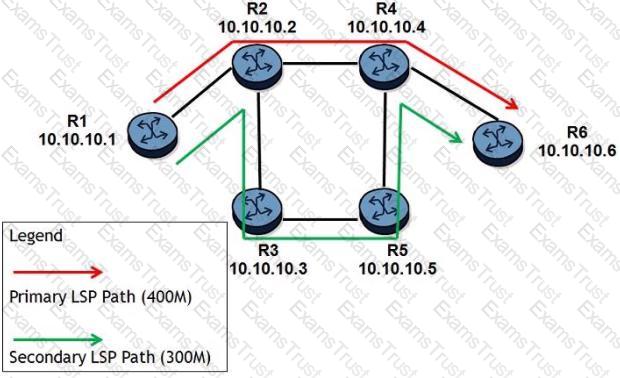
All links have 1 Gbps unreserved bandwidth initially. After the LSP's primary and standby secondary paths are signaled, how much bandwidth is reserved on the link between routers R1 and R2?
Click on the exhibit.
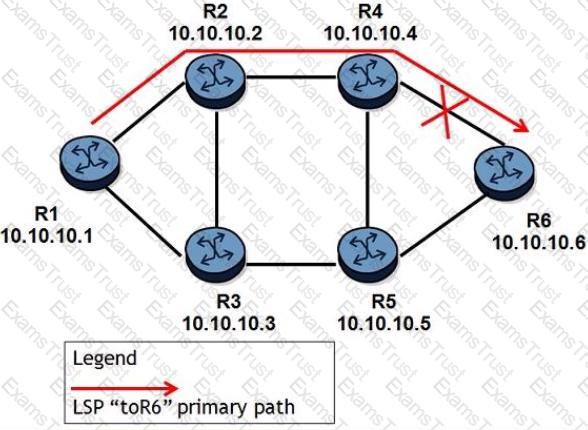
An LSP path is established on router R1 toward router R6. After router R4 detects that the link between routers R4 and R6 goes down, which of the following will affect the failure propagation time?
Which of the following statements are TRUE regarding sdp-ping? (Choose 3)
Which of the following is NOT required to configure an Alcatel-Lucent 7750 SR as a PE router running 6PE?
A customer requests that their Layer 2 Ethernet service be configured to forward frames up to 9000 bytes. The service provider is using MPLS encapsulation. What is the minimum MTU setting for the network ports?
Which of the following about LDP sessions is TRUE?
Click on the exhibit.
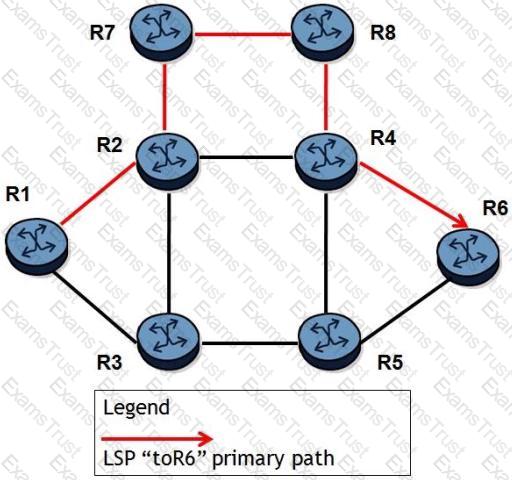
A fully loose LSP "toR6" is configured. All links have the same cost and all routers are Alcatel-Lucent 7750 SRs. The LSP currently traverses the path R1-R2-R7-R8-R4-R6 and the resignal timer is enabled. Which of the following about this LSP is FALSE?
Which of the following about the Alcatel-Lucent 7750 SR command "own Isp-trace" is FALSE?
Which OAM command can be used to verify the correct and consistent provisioning of a service between two service end points?
Click on the exhibit.
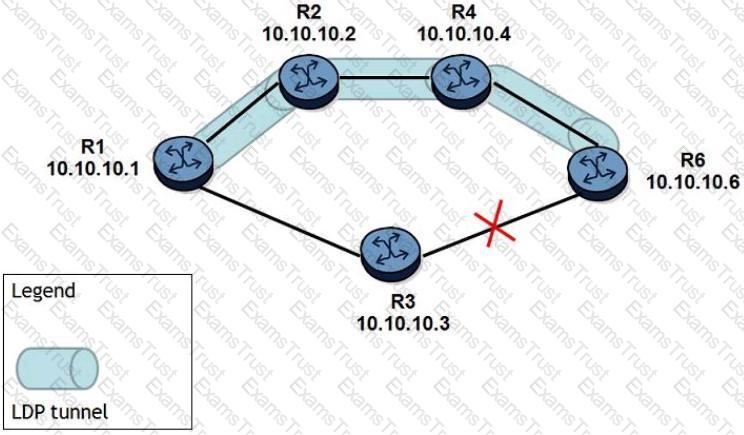
An LDP tunnel is established on R1-R2-R4-R6 because the link between routers R3 and R6 is down. With the LDP-IGP Sync feature enabled and after the link is restored, which of the following is FALSE?
Which of the following statements is FALSE regarding 6VPE?
A technician sitting in a Network Operations Center would like to set up a remote mirror on an Alcatel-Lucent 7750 Service Router to examine some data traffic ingressing a port at a remote site. Which of the following are required? (Choose 2)
In OSPFv3, which of the following LSA types carries prefixes and is only flooded in the area where it is generated?
Which function or component of the Alcatel-Lucent 7750 SR is in charge of supporting dynamic routing protocols and constructing the routing table?
Click on the exhibit button below. Assume the following:
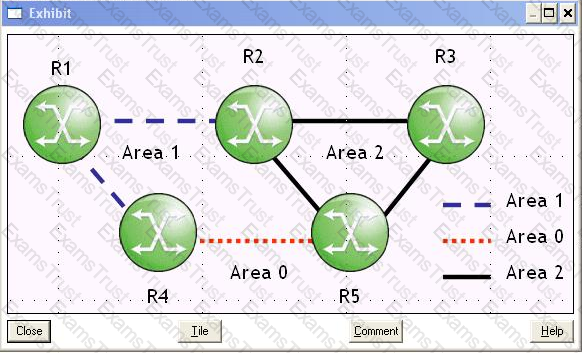
- Each router's OSPF interfaces are in the areas shown.
- Bidirectional LDP-over-RSVP tunnels extend from routers R1 to R3 and back over the path R1-R4-R5-R3.
- You enable fast reroute facility bypass on the R5-R3 RSVP LSP.
- Router R5 acts as a PLR, protecting the R5-R3 link by building a bypass tunnel through router R2.
You build a layer 2 VPN on routers R1 and R3, using the LDP-over-RSVP tunnels. What MPLS configuration step must you complete on router R2 for it to protect the end-to-end service?
Which OSPFv3 LSA advertises the location of an ASBR?
Click on the exhibit.
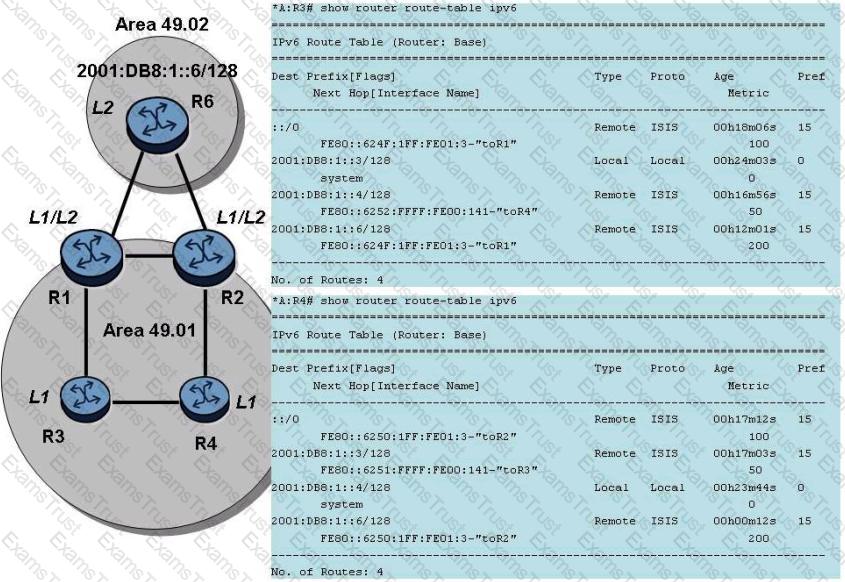
Based on the topology shown and the route tables of routers R3 and R4, which of the following is correct?
If the OSPF reference bandwidth is set to 1000 Gbps. what is the cost of a 1 Gbps interface?
Which of the following best describes the function of an OSPF Type 4 LSA?
Click on the exhibit.
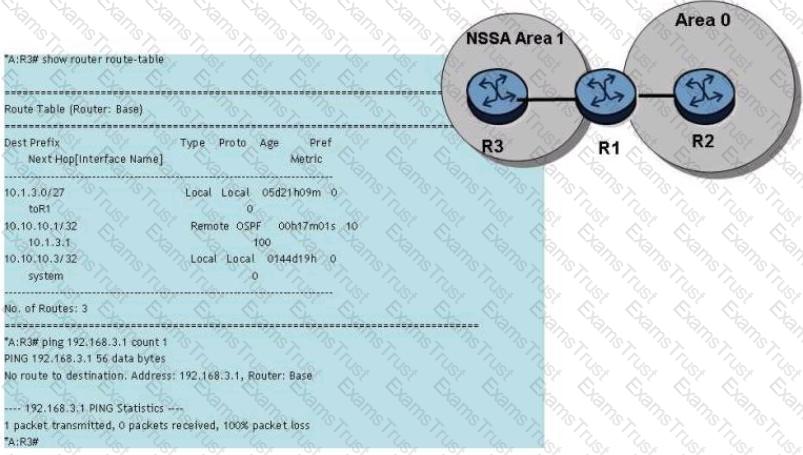
192.168.3.1 is a loopback interface on router R2 and is distributed to OSPF area 0, but the ping fails from router R3.
Which of the following is a possible solution to the problem?
What are the three databases that are maintained by a link-state protocol?
Which one of the following statements regarding the detour object transported in the detour path message is true?
Click on the exhibit button below.
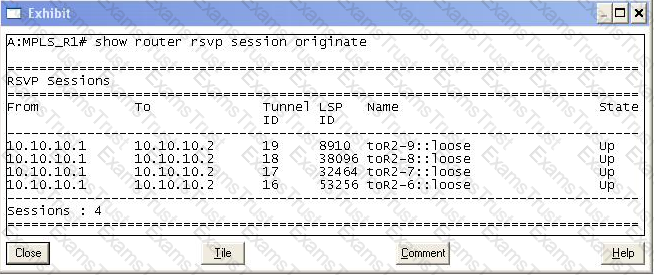
Which fields in this output uniquely identify the RSVP session belonging to a single LSP? (Choose three)
Click on the exhibit.
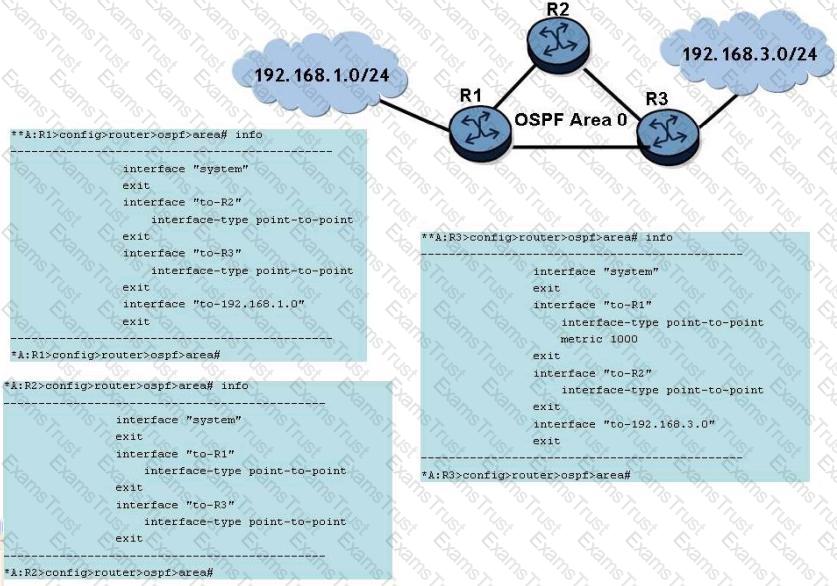
All ports in the network are operationally up and have a speed of 1Gbps. Which of the following is TRUE?
True or False? MPLS may use an existing data link layer header field to identify a label, instead of using a specific MPLS header
Which of the following regarding IS-IS DIS is FALSE?
When IS-IS is electing a DIS, what is used as the tie breaker on an Alcatel-Lucent 7750 SR, if the priorities are the same?
Which of the following message types does RSVP use to set up an LSP? (Choose two)
Click on the exhibit.
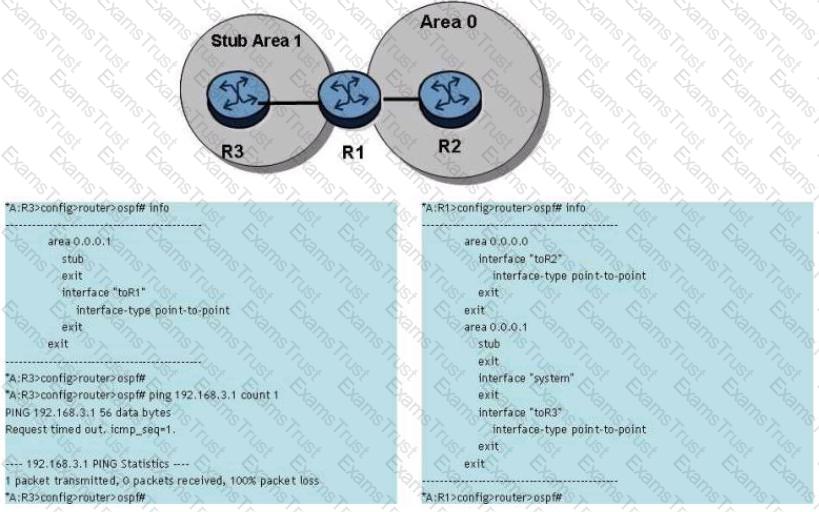
192.168.3.1 is a loopback interface on router R2 and is distributed to OSPF area 0, but the ping fails from router R3. Which of the following is a possible solution to the problem?
Click on the exhibit.
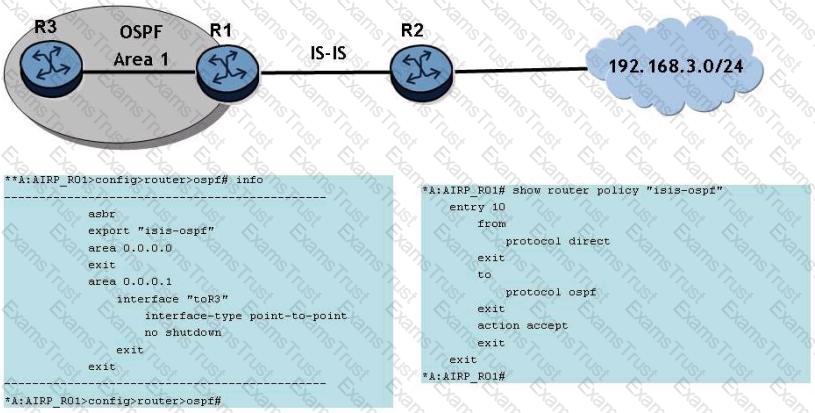
Router R1 learns the network 192.168.3.0/24 from IS-IS. Given the OSPF configuration shown, why isn't the 192.168.3.0/24 route in router R3's route table?
Which of the following is a primary cause of IP hyper-aggregation?
Click on the exhibit.
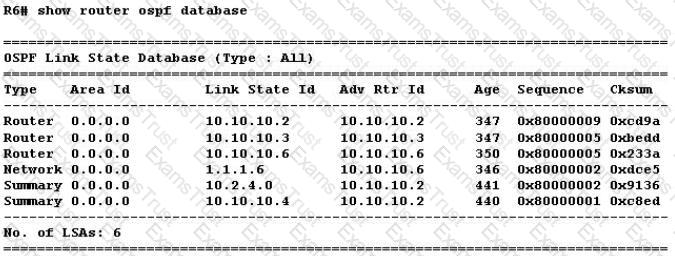
Given the output shown, which router is the ASBR in this network?
Click on the exhibit.
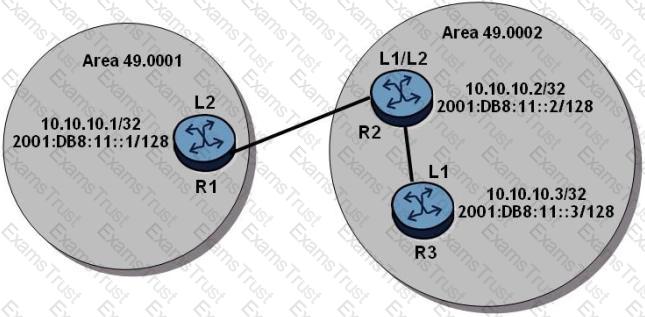
The routers have an established IS-IS L2 adjacency on which IPv4 system addresses are exchanged. An operator successfully configures multi-topology IS-IS routing so that the IPv6 system addresses are also exchanged between routers.
After IPv6 has been configured, which of the following is TRUE?
If the destination IP address of a received unlabeled packet is successfully matched in the FIB, which of the following statements are true? Choose two answers.
Click on the exhibit button below.
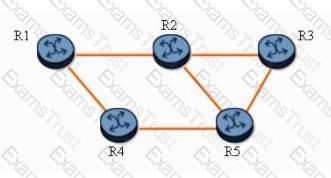
With fast reroute enabled, and given the following:
Which of the following statements is true? (Choose two)
Which of the following best describes constraint-based routing?
When a router performs the SPF calculation, which router is used as the root of the shortest path tree?
Which of the following devices can originate an opaque LSA?
An OSPF router receives an update in which the sequence number, age, and checksum are the same as the entry already in the topological database. What action does the router take?
Which of the following TLV fields is included in an IS-IS Hello packet on broadcast interfaces but not on point-to-point interfaces?
Click on the exhibit.
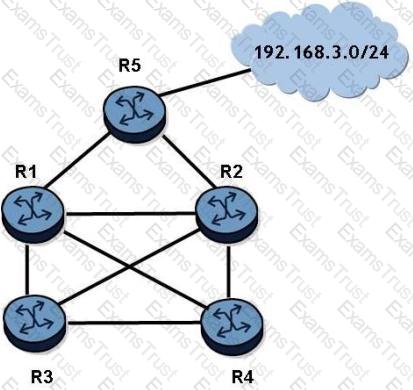
OSPF is operational on all links in the network diagram, all routers are the same cost, and all routers are configured with an ECMP value of 4. Router R5 advertises the prefix 192.168.3.0/24 into OSPF.
How many entries for prefix 192.168.3.0/24 will be in router R3's routing table?
Which of the following correctly describes an IPV6 header compared to an IPv4 header?
An OSPF backbone area contains Type 5 LSAs. If an attached area receives only Summary LSAs from the backbone area, what type of area is the attached area?